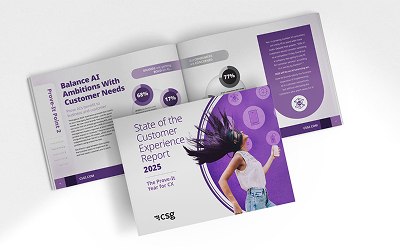The time for speculating about AI—and whether it can enhance customer experience (CX)—is over. For forward-thinking organizations, it’s time to put it to use.
Plenty of CX teams are going full steam ahead. In a recent study by CCW Europe Digital, 54% of customer management leaders said they’ve already invested in CX-focused AI technology, with 30% planning to deploy a new AI tool within the next six months.
But organizations also have plenty of concerns as they implement AI—and learn about it as they go. Nearly half of the survey respondents (45%) were concerned about the implementation and management costs of AI, and 37% were worried about the lack of internal AI skills or knowledge. You can read the study here.
In a recent webinar, “Beyond the Hype: The Real Potential for AI in CX,” a panel convened to offer expert advice on AI and the customer experience. Moderated by CSG’s Mathieu Acin, VP of global GTM, customer experience, the panel featured these leaders:
- Mark DeSimone, SVP of operations and digital evolution, CableOne
- Mandy Bath, head of technical AI, Merkle
- Tilly Gilbert, director, consulting & edge practice lead, STL Partners
The discussion dug in on topics from organizational readiness to transparency in customer interactions. Watch the full video, or read on to see some of the major takeaways.
How to Make an Enterprise AI Strategy Stick (Not Stall)
CX leaders can struggle to get buy-in on AI-powered tools unless they can demonstrate tangible value. Without aligning an AI use case with the organization’s business objectives, AI initiatives risk becoming fleeting trends rather than sustainable solutions.
CableOne’s Mark DeSimone stressed the importance of having a dedicated steering committee for AI initiatives. This committee would oversee AI and digital transformation efforts, helping to determine that all initiatives line up with the company’s goals. Getting key stakeholders involved from various departments is essential, he added. Their feedback and input can guide the AI and customer experience strategy, making sure it addresses real business needs and customer pain points.
Leaders can keep AI projects from seeming trendy if “you can get some quick wins and create that buy-in, and create that energy throughout your organization,” Mark said. “That’s how you get people accepting [AI] and wanting to know more about it, and also to apply it to their area of the business.”
3 Keys to Readiness in AI Implementation
The CCW Europe Digital survey revealed a readiness gap in AI and customer experience—only 54% of respondents said their organizations were at least moderately mature in their ability to use AI technology for CX. Even fewer (49%) said their teams were at least moderately equipped to handle and manage it.
The panelists discussed these elements of an AI-ready organization:
- Data quality. AI is only as good as the data it processes. “AI maturity goes hand in hand with data maturity,” said Mandy Bath, whose role at Merkle is to help assess organizations’ readiness for AI. Organizations should assess whether data is trapped in silos across the organization, which could limit the effectiveness of AI initiatives that need to integrate those datasets.
- Infrastructure. Organizations should also look at their tech stack to determine if it can support AI applications. For example, can different systems integrate seamlessly? Does the organization have sufficient computational power and storage?
- Culture. When it comes to getting results with AI-powered CX initiatives, the human decision-makers are just as important as the technology. Leaders need to embrace data-driven decision-making and continuous learning, setting that example from the top-down.
“You have to be bold and courageous for change, and be willing to try things,” Mark said. “And that’s how you spark your culture inside your company to be innovative and creative.”
Practical Tips for AI Implementation
Which organizations are already making AI work for them? And what are they doing that sets them apart from the others? One in nine respondents (11%) in the CCW Europe Digital survey said AI tools have had a “significant positive impact” on revenue generation, while 25% said they’ve had a “moderate positive impact.”
“Enterprises that seem to be doing well tend to have both a very clear structure at the top level as to who is going to be responsible for pushing forward AI and for looking to bring that to the organization,” said Tilly Gilbert of STL Partners. She added that those leaders have also thought about how to cascade information down to less-senior members, “who are really the beating heart” that drives AI and customer experience initiatives forward.
Use metrics to measure and motivate. One key is to establish KPIs that measure the success of AI projects and ensure they align with broader business goals. Organizations can also establish incentives that motivate employees to adopt AI initiatives, Tilly said. Those metrics are also important for before-and-after case studies, which teams have published internally to highlight their AI successes and win buy-in for additional projects.
Start simple, build momentum. For organizations that are just getting started with an enterprise AI strategy, it’s best to keep things simple. These might be automation projects where the data availability is more straightforward, like recommendation engines that suggest products or services to customers, or rules-based chatbots. Getting quick wins in smaller projects can help build confidence and support for more complex projects down the line.
Learn what’s worked for others. Part of the value of working with vendors in the AI space is that they can share examples of real-world use cases. Especially starting out, there’s no need to re-invent the wheel. “Why not start with something that already has proven return on investment from a competitor or a similar company to your own?” Tilly suggested.
Be transparent with customers. Even if the general population is growing more comfortable with interacting with AI, many consumers don’t want AI forced upon them in lieu of human agents. Companies should clearly signal to customers when they’re interacting with an AI-powered agent. They should also allow them to opt out of those interactions or choose alternative channels. “I think you build a lot of trust with your customers if you’re just open and honest about where and how you’re using AI,” Mandy said.
Get the Rest of the Insights
These tips only scratched the surface. For more advice on how to get started—and get wins—using an enterprise AI strategy for CX, check out the webinar, “Beyond the Hype: The Real Potential for AI in CX.”











